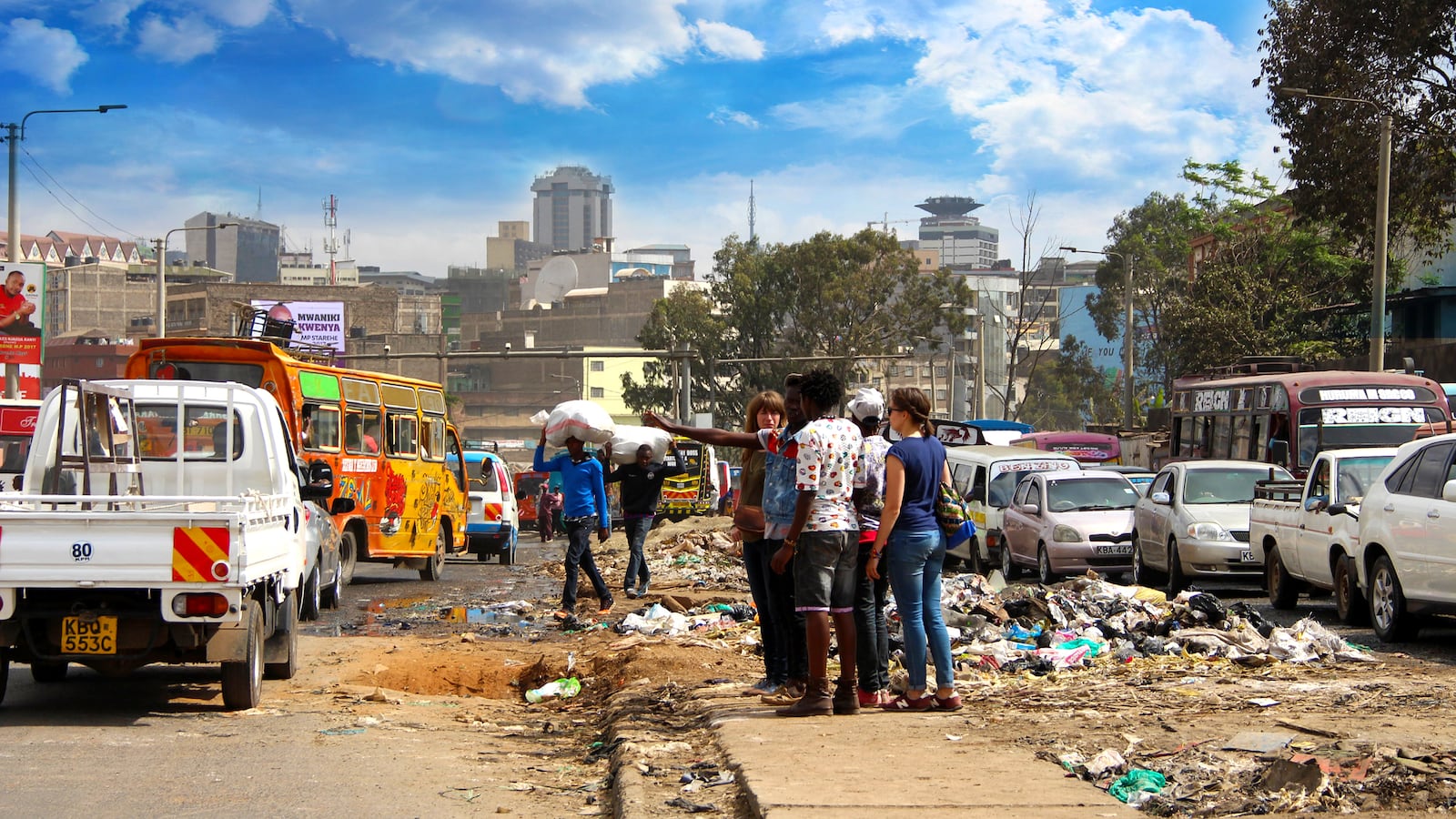NAIROBI—Thanks to its white sandy beaches and world-famous parks, Kenya is a must-visit for many of the world’s travelers. Nairobi, however, champions storytelling as a way to spread its rich culture, and has been at the center of a trend emerging roughly a decade ago called poverty or slum tourism.
Tourists are guided along houses made of jagged iron sheets and topped with rusty tin roofs in poorly developed slums, the most famous being Africa’s biggest urban slum, Kibera. The neighborhood, which houses 250,000 people over a 2.5 square-kilometer area, is known for its poor sanitation conditions seen in open sewers and lurking diseases.

Elementary school students walk on the ground where they plant trees during the community cleanup event supported by UN Environment at Kibera slum in Nairobi, Kenya, on Africa day which commemorates the founding of the Organisation of African Unity (OAU now the AU), on May 25, 2018
Yasuyoshi Chiba/GettySitting just over six kilometers from the glitzy skyscrapers of Nairobi’s central business district, Kibera plays host to a dysfunctional, colonial-era railroad and tumbledown houses. Having been a backdrop to The Constant Gardener film or Capheus’ neighborhood on Sense8, such tours gained prominence and you can easily see tourists strolling along garbage-lined roads however ethically-questionable it is.
So why is poverty tourism booming in Kenya? Alistair Amendi, Tour Manager of Explore Kibera says that attention was drawn towards Kibera in the post-election violence around 2008, except negatively.
“Kibera was the center of all political activities. A big number of people living in a very small area attracted a lot of violence which resulted in a negative image for Kibera,” says Amendi. Amendi adds that along with such image came a lot of positives and this is when Amendi and his co-founder Albert Chi thought of establishing Explore Kibera. “We wanted to show what’s happening behind the scenes. And it was officially in 2009 that we started the tours,” he continues.

While slum tourism often conjures up the unsavory image of ethically-dubious foreigners, Amendi told me that even Kenyans developed curiosity about Kibera and started signing up to the tours. Amendi talked of his tour agency’s uniqueness through introducing the visitors to interesting initiatives around the slum. By pairing with organizations and young people, they manage to introduce the slum visitors to small initiatives specialized in recycling activities such as making postcards from recycled papers, as well as schools. “A lot of the time the people we take to see these initiatives end up supporting them,” he notes.
Amendi highlights that taking photos is restricted out of respect for the Kibera residents. Those same residents however are willing to share their stories and break bread with the tourists. He also dismisses rampant violence and insecurity claims saying that the slum houses a vibrant community and that there are hardly any escalations. Tours usually include no more than 10 people at a time. “The community accepts such tours since part of the revenue indirectly goes back to the slum inhabitants or even cover [kids’] school fees,” Amendi adds.
According to Felix Oriang, Founder of Kibera Tours, it was the foreigners showing huge interest in slums that turned it into a living for him. “They used to just show up at Kibera not knowing [whom] to contact,” Oriang says. He adds that the point is to demystify the notion that people that live in the slums are all about suffering and only the less fortunate reside there. All calibers of people reside in the slum; from those who live below $1 a day, to those that own the shanties that most of us call home. “The tours are for informing people that there is more to Kibera than just the brown iron sheets you see while passing on a chartered plane from Wilson airport or while driving along Langata Road,” he explains.
According to Kibera Tours, a visitor’s experience differs depending on what they are there for.

People stand on their balcony in the building where live the wife of Paul Omina, Dorothy Achieng (unseen), on October 28, 2017, in the Mathare slums of Nairobi, a stronghold of Kenyan opposition leader.
Georgina Goodwin/Getty“Living in the ghetto is just the same as living in the suburb, the only difference is that we can talk with our neighbor while still in the house (just shout from your house) and have a simple conversation, ask the neighbor for salt in the middle of the night and not see anything wrong with that. Where one is able to look after the child of a neighbor and expect nothing back...there are a lot of things here!” Oriang passionately adds.
The feedback received by these tour companies are usually positive reflecting on the informative nature of these tours.
My experience at the slum was not much different: I took a Little, a Kenyan ride-hailing app car, to Kibera with little to no expectations. Having seen a sightly painting hung at a co-working space, my visit was mainly driven by the desire to learn more about this art gallery/art school called Uweza Art Gallery. The gallery is an initiative for students anywhere between 7-37 years old which allocates 60% of its revenues to cover the students’ regular school fees while the rest is for the gallery’s service fees. The initiative has also been found to keep more kids at school now that their school fees are paid for.
My tour through the slum was eye-opening and people were mostly friendly and hospitable. I was offered a full history on the old neighborhood and nearby organizations. And despite the scant resources you can see walking down the slum, different kinds of stores can still be seen dotting the sides of the roads.
Slum tourism isn’t the only major industry development in Nairobi affecting these communities. This year, two entrepreneurs, Gianmarco Marinello and Sriram Damodaran, collaborated to start an initiative called Nai Nami that would take visitors on tours across uptown and downtown Nairobi. The purpose of initiative is to employ the youth from slums such as the Mathare slum and build on their street skills, through income-generating activities. “These guys grew up on the street; nobody else is better at telling stories than them,” Marinello says. “We wanted people to come and see how the locals lived,” he adds. Marinello echoed Damodaran’s statement saying that Nai Nami wanted to tell stories through the eyes of former street children as the main focus.
Nai Nami garnered a 98% satisfaction rate on TripAdvisor with the help of the two founders and their 3 main guides, Cheddaz (Joshua Kimani), Kissmart (Godfrey Bakira), and Donga (Moses Otieno). The main experience Nai Nami is aiming for is acquiring a fresh perspective, especially on underprivileged individuals who turn their lives around once opportunities come their way. “We have a lot of visitors who went back home but are still supporting Nai Nami through recommendations and raising awareness,” Damodaran says.
During my Nai Nami tour, I was accompanied by Donga who told me of his plight as a child. Especially after losing his father, he turned to pickpocketing, armed robberies and other illegal activities. But now he tells stories of the streets he once called home. Strolling through the downtown area of Nairobi, Donga pointed at the old buildings that left marks in history as well as the building former American president Barack Obama used to holiday in with his family. The tour ends with a hearty authentic Kenyan meal and chai.
It’s incredibly hard to define or limit Nairobi to a site or an activity but touring the city itself seems to rise in tandem with visiting the giraffe center for a cute feeding-the-giraffe snapshot. What makes these ventures extra special is the sustained hunt for good opportunities to offer the city’s most disadvantaged locals — something that puts humans first.






